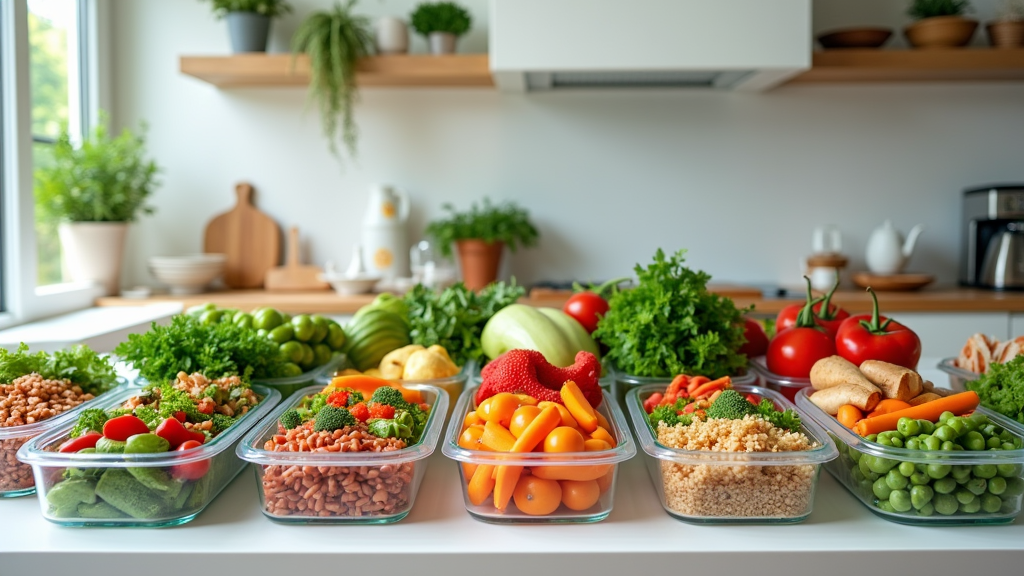How To Meal Prep For A Balanced And Healthy Week
Meal prepping isn’t just some food trend; it’s one of my most reliable ways to save time, eat better, and cut down on last-minute stress during my week. Planning out meals for just one week can make a huge difference in how balanced and healthy my diet turns out. Getting started is easier than most people think, and it’s pretty satisfying to have a fridge full of ready to go options. Here, I’ll share my experience and tips on prepping meals for a healthy and balanced week, whether you’re cooking for yourself or a whole family.

Why Meal Prep Makes a Difference
Meal prepping helps me avoid those random, less healthy food choices when I’m tired or pressed for time. Instead of grabbing takeout after a long day, I can pick something I prepped ahead; a homemade bowl, salad, or wrap. It’s also a lot easier to keep portions in check and to make sure I actually eat fruits, veggies, whole grains, and good proteins.
There’s research backing up how meal prepping helps people stick to nutrition goals and eat better over time. When I have my meals mapped out, it stops me from buying groceries I don’t use, which helps my wallet and reduces food waste. Prepping also fits lots of lifestyles, whether I’m plant based, need glutenfree meals, or simply want to include more veggies. The trick is making it work for me, with foods I actually look forward to eating. Weekly meal prepping also gives a boost to my energy in the long run because I don’t have to stress about what’s for dinner every night.
Setting Up for a Meal Prep Week
Having a solid plan keeps things from getting overwhelming. I like to start with a quick check of what I need out of my week. Am I at work all day and need grab and go lunches? Do I eat dinner at home most nights? This helps me figure out how much food I should prep and which meals make the most sense to tackle ahead.
- Pick a Meal Prep Day: I usually choose Sunday, but whatever day gives me a chunk of free time works. Setting aside 1 to 2 hours is enough for simple batches.
- Check My Schedule: If there’s a night out or a day when lunch is provided, I leave those open so I’m not prepping more than I’ll eat.
- Prep Gear I Use: Investing in a few reusable containers (think glass storage with tight lids, or bentostyle lunchboxes) is totally worth it. A good sheet pan, rice cooker, or Instant Pot also streamlines batch cooking.
If you’re new, my biggest advice is to start small. You don’t have to prep every single meal for the week in your first try. Even just getting ahead on lunches or breakfasts brings noticeable benefits.
Building a Balanced Meal Prep Menu
Making meals balanced is the key to not getting bored or feeling deprived. My go to formula is pretty simple: start with a healthy protein, add a fiberrich carb (like brown rice, sweet potato, or quinoa), and load up on at least two kinds of veggies. I change up spices or sauces to keep things interesting.
Here are a few ways I choose my meal combos:
- Protein – grilled chicken, shrimp, tofu, lentils, eggs, or turkey meatballs
- Whole grains or starchy veggies – brown rice, quinoa, farro, barley, wholewheat pasta, sweet potatoes, or corn
- Fresh and cooked veggies – roasted broccoli, raw spinach, grilled peppers, carrots, snap peas, kale, or cabbage slaw
- Healthy fats – hummus, avocado, nuts, seeds, or a drizzle of olive oil
Changing up one part of the combo, like swapping turkey for beans or broccoli for green beans, means I don’t have to eat the exact same thing every day, but I still keep things simple. Remember, it’s all about food that’s nutritious, filling, and tasty, so you stick with it.
Besides that, using fun flavor profiles, like Mediterranean, Thai, BBQ, or Mexican, helps keep my taste buds happy and mixes in some variety. Balancing sweet and savory combinations (for example, roasted sweet potatoes with spicy beans) can also keep things interesting if you find regular combos getting boring.
Quick Steps for Weekly Meal Prep
This is my usual approach to prepping for a full week:
- Map Out My Menu: I write out what I want to eat for breakfast, lunch, and dinner. Even jotting it down on a sticky note helps.
- Make a Grocery List: I check what I already have at home so I don’t buy extra, then make a focused shopping list by category (produce, proteins, pantry items).
- Batch Cook Staples: Cooking a big pot of rice or quinoa, baking or roasting proteins, and chopping vegetables are the basics. I usually roast veggies on a sheet pan so I get crispy edges, and it saves time washing up.
- Portion Out Meals: Once things cool, I portion meals into containers. Mixing hot and cold foods, like greens and roasted chicken, keeps things fresh, and I always add dressings or sauces right before eating.
- Store and Label: I label the containers with what’s inside and the date. Meals last about 4 days safely in the fridge, so for the weekend, sometimes I freeze a couple if I need them to last longer.
Another trick I like is prepping a couple of sauces or dressings at the start of the week. This makes it easy to switch things up and avoid flavor fatigue while adding a bit of homemade flair to whatever I’m eating throughout the week.
Meal Prep Ideas for Every Part of the Day
Having options for every meal, plus snacks, helps me power through the day without reaching for less healthy stuff.
Breakfast Prep
- Overnight oats with almond milk, chia seeds, fruit, and a sprinkle of nuts
- Egg muffin cups with spinach and tomatoes
- Greek yogurt parfaits in jars with berries and granola (keep granola separate for crunch)
- Homemade breakfast burritos (wrap, eggs, beans, salsa) wrapped and frozen for grab and go mornings
- Peanut butter banana smoothies portioned in freezer bags—just dump in a blender with milk and blend when ready
Lunch and Dinner Prep
- Grilled chicken or tofu, brown rice, and roasted mixed veggies with a tahini drizzle
- Lentil soup or chili, portioned into grab and go containers
- Stirfried shrimp and snap peas with soba noodles, toss the noodles in sesame oil to keep them from sticking
- Turkey meatball bowls with quinoa, spinach, and marinara—layered for easy reheating
- Stuffed bell peppers with lean ground turkey, brown rice, beans, and corn
Snack Prep
- Veggie sticks with hummus
- Fruit salad (stored with a squeeze of lemon juice to keep it fresh)
- Single portion bags of trail mix or nuts
- Energy balls (oats, nut butter, honey, mini chocolate chips) for an afternoon boost
- Hard boiled eggs
Things Worth Thinking About Before Starting Meal Prep
Meal prepping has its little speedbumps, but most are easy to smooth out with a bit of practice.
- Storage Space: My fridge fills fast, so I try to use stackable and spacesaving containers. Freezersafe bags work well for soups and stews.
- Batch Sizing: Making too much of one meal gets boring for me. I prep two or three different mains and swap ingredients around for a bit of variety.
- Keeping it Fresh: Some foods, like leafy greens, don’t last all week, so I prep salad bases and add dressing or toppings right before eating.
- Enjoyment Factor: If I’m craving something, I find a way to include it. Forcing myself to eat meals I don’t like just leads to snacking later.
- Allergies and Preferences: I keep allergies and dietary preferences in mind—both mine and anyone I might be feeding. This helps avoid food waste and keeps everyone happy.
Storage Tips and Food Safety
Food safety matters, especially when prepping ahead. I cool everything before sealing containers, and I always reheat meals thoroughly, especially meat, poultry, or rice. For things that need to stay crisp, like fresh salads, I keep dressings and toppings on the side. Using the freezer for a portion or two means nothing goes to waste by the weekend.
More Handy Meal Prep Tips
Being flexible with ingredients, using seasonal produce, and planning for leftovers makes meal prep even better. Here are a few extras I’ve found helpful:
Mix and Match: Prepping basic proteins and grains lets me build different meals throughout the week just by changing up veggies or sauces.
Theme Nights: Sometimes, I plan for a taco night, stirfry night, or pasta night. This keeps things fun and gives me something to look forward to.
Low Effort Cooking Methods: Using a slow cooker, pressure cooker, or roasting trays means I can set things and come back when it’s done, a super handy trick if I need to multitask.
Don’t Forget Snacks: Prepping little extras like energy balls, cut fruit, or boiled eggs stops me from random snacking that isn’t always so healthy.
Keep it Realistic: Trying to make everything perfect can lead to burn out. I aim to prep just enough for 3 or 4 days instead of the whole week at once. This way, I keep those meals fresh and never feel like I’m “stuck” with leftovers I don’t want to eat. Keeping it simple is what makes meal prep stick. Trying to do too much can burn anyone out, so it’s better to start with a couple of meals and build up from there if needed.
FAQs about Weekly Meal Prep
People getting into meal prepping often ask me these questions:
What’s the best way to avoid meal prep burnout?
Switch up the recipe types each week and don’t commit to prepping every single meal at first. Even prepping lunches or just dinners is a win.
How do I keep meals interesting?
Spice blends, sauces, and using different proteins help a lot. I also watch what’s on sale for seasonal produce and try new sides or add ins. You can mix in some variety by changing sauces or combining ingredients in new ways.
How far ahead can I safely meal prep?
Most meals keep for about four days in the fridge. I freeze extra portions if needed, and always reheat foods until they’re piping hot before eating.
Wrapping Up Healthy Meal Prep
Getting into meal prep for one week makes balanced eating realistic even on the busiest days. Setting up a basic plan, keeping portions under control, and not being afraid to try new combos helps keep it enjoyable and stress free. The key is making it fit my lifestyle and taste preferences; it’s really about finding what works for me and tweaking along the way. Sticking with it saves me time, helps me eat better, and puts way less pressure on my daily routine. Worth trying for anyone who wants more organized, healthier meals at their fingertips! Remember, a little effort at the start of your week sets you up for more energy, better choices, and less daily stress as the days roll by.

Meal prepping is one of the most effective habits I’ve adopted for maintaining a healthy lifestyle. It not only saves time during the week but also reduces the temptation to opt for unhealthy last-minute meals. I’ve noticed that when I plan ahead, I make more balanced choices and feel less stressed about what to eat each day. It creates a structure that actually gives me more freedom, not less.
Welcome To Feel GreatThank you for your post and to me it’s all about trying to stay as healthy as possible, and save energy. Live the best life you can and make the best choices that you can as far as your health concern..